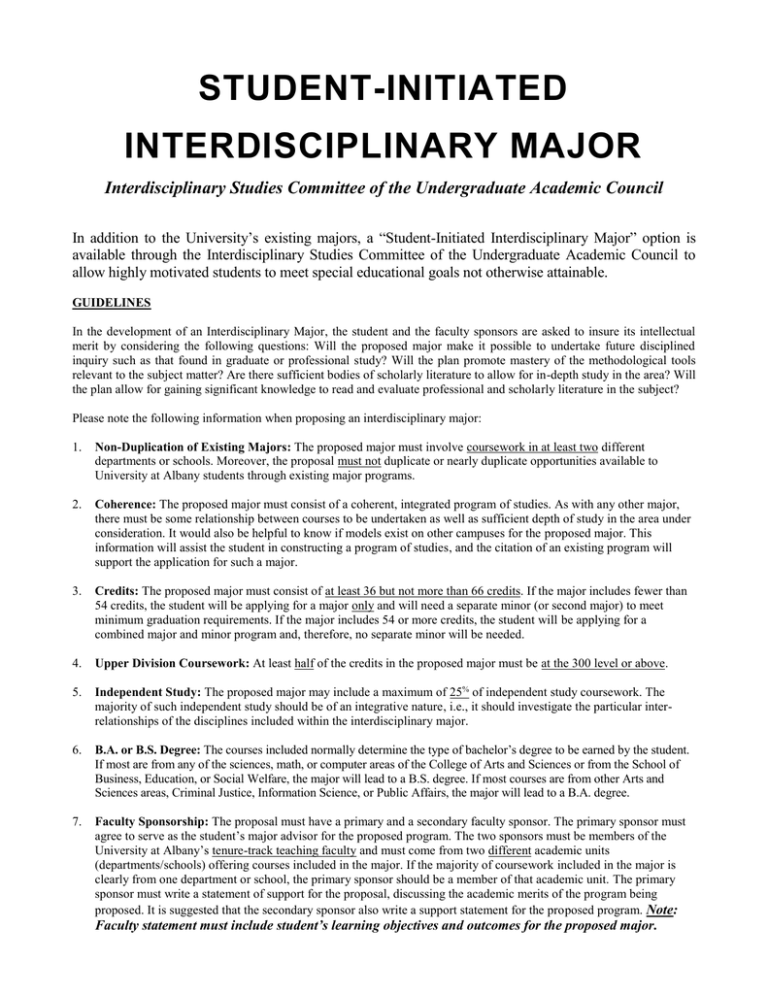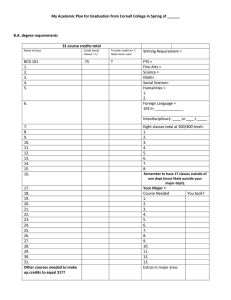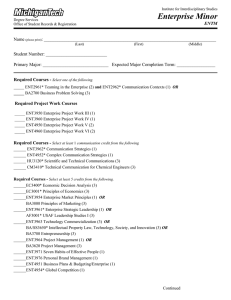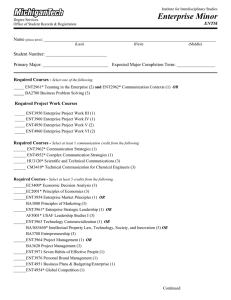Student-Initiated Interdisciplinary Major
advertisement

STUDENT-INITIATED INTERDISCIPLINARY MAJOR Interdisciplinary Studies Committee of the Undergraduate Academic Council In addition to the University’s existing majors, a “Student-Initiated Interdisciplinary Major” option is available through the Interdisciplinary Studies Committee of the Undergraduate Academic Council to allow highly motivated students to meet special educational goals not otherwise attainable. GUIDELINES In the development of an Interdisciplinary Major, the student and the faculty sponsors are asked to insure its intellectual merit by considering the following questions: Will the proposed major make it possible to undertake future disciplined inquiry such as that found in graduate or professional study? Will the plan promote mastery of the methodological tools relevant to the subject matter? Are there sufficient bodies of scholarly literature to allow for in-depth study in the area? Will the plan allow for gaining significant knowledge to read and evaluate professional and scholarly literature in the subject? Please note the following information when proposing an interdisciplinary major: 1. Non-Duplication of Existing Majors: The proposed major must involve coursework in at least two different departments or schools. Moreover, the proposal must not duplicate or nearly duplicate opportunities available to University at Albany students through existing major programs. 2. Coherence: The proposed major must consist of a coherent, integrated program of studies. As with any other major, there must be some relationship between courses to be undertaken as well as sufficient depth of study in the area under consideration. It would also be helpful to know if models exist on other campuses for the proposed major. This information will assist the student in constructing a program of studies, and the citation of an existing program will support the application for such a major. 3. Credits: The proposed major must consist of at least 36 but not more than 66 credits. If the major includes fewer than 54 credits, the student will be applying for a major only and will need a separate minor (or second major) to meet minimum graduation requirements. If the major includes 54 or more credits, the student will be applying for a combined major and minor program and, therefore, no separate minor will be needed. 4. Upper Division Coursework: At least half of the credits in the proposed major must be at the 300 level or above. 5. Independent Study: The proposed major may include a maximum of 25% of independent study coursework. The majority of such independent study should be of an integrative nature, i.e., it should investigate the particular interrelationships of the disciplines included within the interdisciplinary major. 6. B.A. or B.S. Degree: The courses included normally determine the type of bachelor’s degree to be earned by the student. If most are from any of the sciences, math, or computer areas of the College of Arts and Sciences or from the School of Business, Education, or Social Welfare, the major will lead to a B.S. degree. If most courses are from other Arts and Sciences areas, Criminal Justice, Information Science, or Public Affairs, the major will lead to a B.A. degree. 7. Faculty Sponsorship: The proposal must have a primary and a secondary faculty sponsor. The primary sponsor must agree to serve as the student’s major advisor for the proposed program. The two sponsors must be members of the University at Albany’s tenure-track teaching faculty and must come from two different academic units (departments/schools) offering courses included in the major. If the majority of coursework included in the major is clearly from one department or school, the primary sponsor should be a member of that academic unit. The primary sponsor must write a statement of support for the proposal, discussing the academic merits of the program being proposed. It is suggested that the secondary sponsor also write a support statement for the proposed program. Note: Faculty statement must include student’s learning objectives and outcomes for the proposed major. PROPOSAL DEVELOPMENT AND APPLICATION PROCEDURES 1. Students who believe they might like to construct their own major should begin plans as soon as possible, but the application for the major cannot be filed until the student has completed at least 30 graduation credits. 2. Once a student has tentatively decided on the theme for the proposed study, the Undergraduate Bulletin should be reviewed to verify that no existing major encompasses that theme. The Bulletin and the Schedule of Classes should also be used to identify possible courses which might be included in the proposed major and, based on the courses they teach, possible faculty who might be willing to serve as sponsors for the major. 3. Before deciding on all the details of the proposed major, the student should speak with several faculty for the following reasons: (a) to determine the likelihood of finding two faculty sponsors for the program; (b) to solicit suggestions on how to further refine, limit, or expand the chosen theme; (c) to solicit further suggestions of individual courses or sequences of courses which might be included in the major; and (d) to determine whether or not the student’s goals in creating the major are likely to be met by the combination of course chosen. 4. Once the theme of the proposed major has been decided, the student should work with the two faculty sponsors to draw up the Major Proposal. It must be remembered that the student-initiated interdisciplinary opportunity is intended to encourage a student’s concentration in an area which has sufficient coherence, importance, and scholastic merit to be the subject of a major, even though no formal major program currently exists. 5. In explaining and justifying the proposed course of study, the student’s statement should demonstrate the academic legitimacy of the study. It should also indicate how the program will contribute to fulfilling the student’s overall academic goals, and why these objectives cannot be met within existing Albany programs. This statement should be precise and specific, as well as understandable to readers not familiar with the subject matter. The statement may be as long as the applicant desires to defend the proposed study. The more unusual the subject area, or the less readily apparent its integral character, the more careful this justifying statement ought to be. 6. A list of all courses to be included in the major (36-53 credits) or in the combined major and minor (54-66 credits) must be provided, with an indication of the credits each course is worth, course title, the grade (if completed), and the semester and year in which the course has been or will be taken. (The schedule of future courses is not binding, but the sequencing of courses may be important in judging the major as a whole). 7. Should the actual content of a course in the program differ substantially from the bulletin description or should the program include courses taken at other institutions, a brief description should be provided. The same should be done for any course to be included in the program where the relevance of the course may not be readily apparent. Most important, a specific description must be provided for any independent study courses to be included in the program. 8. The completed Application, signed by both faculty sponsors, the Major Proposal, and the Faculty Sponsor’s supporting statement should be submitted to the Undergraduate Education Office (LC 30) for presentation to the Interdisciplinary Studies Committee. 9. There is no “deadline” for the application; but the sooner it is submitted, the sooner the applicant will know whether the major proposal is acceptable. Since the committee may refuse the proposal, may return the proposal for revision, or may reject some of the proposed courses from the proposal, the student should attempt to submit the proposal before the senior year. Otherwise, the student may have difficulty graduating on time. 10. The Interdisciplinary Studies Committee holds meetings during the fall and spring semesters. Since proposals and applications must be submitted to committee members for consideration prior to a meeting, those submitted after December 1 st or after May 1 st may not be considered by the committee until the following semester. 11. Once a proposal has been approved, a form listing the approved title and courses is sent to the Office of the Registrar. The list of approved courses will be entered into the DARS Degree Audit for the student. Therefore, any changes or exceptions in the approved program, however small, must be approved by the Committee so that information on file with the Registrar can be appropriately revised for degree clearance. 12. Current contact information in the Und ergraduate Education Office (LC 30): Karen McNeill, (518) 442-3950 or kmcneill@albany.edu. 2/9/2012 STUDENT-INITIATED INTERDISCIPLINARY MAJOR APPLICATION An applicant must complete this form, obtain the signatures of two faculty sponsors, and submit this form and the major proposal to Undergraduate Education, LC 30. A supporting statement from your Primary Faculty sponsor is required. PROPOSAL: Carefully read the information on the attached handout. The explanation and justification of your proposed major may be as long or short as you wish, but please realize that it is your responsibility, through your formal written description, to convince the Interdisciplinary Studies Committee that your proposal should be approved. NOTE: all descriptions should be typed single-spaced on 8 ½ x 11 sized paper. NAME_______________________________ DATE_____________________________ LOCAL ADDRESS____________________ STUDENT ID#______________________ E-MAIL____________________________ LOCAL PHONE______________________ CREDITS COMPLETED_______ DATE RECEIVED BY OFFICE ________________ TITLE OF INTERDISCIPLINARY MAJOR (maximum of 20 characters & spaces) THIS WILL BE MY (please circle): FIRST MAJOR THIS WILL BE A (please circle): SECOND MAJOR MAJOR ONLY (36-53 credits) COMBINED MAJOR/MINOR (54-66 credits) ……………………………………………………………………………………………… NOTE: Both Faculty Sponsors must be members of the tenure-track teaching faculty. PRIMARY FACULTY SPONSOR (print name) ________________________________ I have read the student’s proposal for an interdisciplinary major and, being familiar with its focus, recommend approval of this academic program and agree to be this student’s academic advisor. My supporting statement is attached. NOTE: Faculty statement must include student’s learning objectives and outcomes for the proposed major. ___________________________ ____________________________ (Signature) (Department/School) ___________ (Date) SECONDARY FACULTY SPONSOR (print name) _____________________________ ___________________________ _____________________________ (Signature) (Department/School) __________ (Date) ……………………………………………………………………………………………… ACTION OF THE INTERDISCIPLINARY STUDIES COMMITTEE: ( ) APRROVED ( ) NOT APPROVED ( ) OTHER FOR THE COMMITTEE: _____________________________ DATE: ______________ 2/9/2012 COURSE REQUIREMENTS FOR INTERDISCIPLINARY MAJOR Major only (36-53 credits) Combined Major/Minor (54-66 credits) NAME_______________________________ NAME OF MAJOR_____________________ (Please include whether B.A or B.S. Degree) PLEASE NOTE: If your course descriptions differ in any way from those in the Bulletin please attach a separate course description. PLEASE NOTE: At least half (12) of the credits in the proposed major must be at the 300 level or above. COURSE # COURSE NAME # OF CREDITS SEMESTER/YEAR TAKEN Lower Division (below 300 level) Upper Division (300 level and above) Once both the Application and Course Requirement forms have been completed, please submit to Undergraduate Education, LC 30. Remember to attach the following items, along with the Application and Course Requirements form (check off as attached): Major Proposal ____ Faculty Sponsor Statement (including Learning Objectives & Outcomes) _____ Course Descriptions (if different from Bulletin) ____ Current Contact in Dean’s Office: Assistant Dean Karen McNeill, Undergraduate Education, LC 30. 2/9/2012



